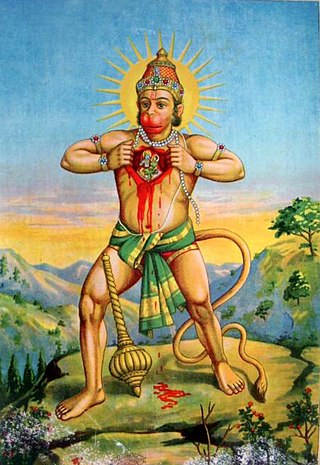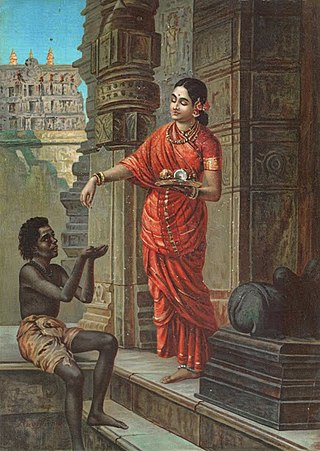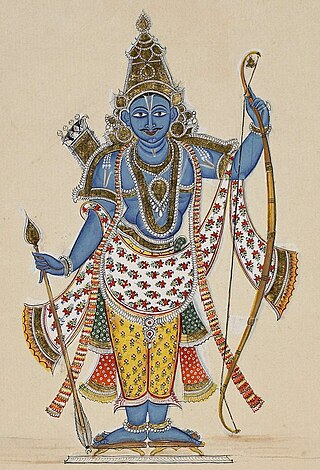
Hanuman, also known as Maruti, Bajrangabali, and Anjaneya, is a deity in Hinduism, revered as a divine vanara, and a devoted companion of the deity Rama. Central to the Ramayana, Hanuman is celebrated for his unwavering devotion to Rama and is considered a chiranjivi. He is traditionally believed to be the spiritual offspring of the wind deity Vayu, who is said to have played a significant role in his birth. In Shaiva tradition, he is regarded to be an incarnation of Shiva, while in most of the Vaishnava traditions he is the son and incarnation of Vayu. His tales are recounted not only in the Ramayana but also in the Mahabharata and various Puranas.

Valmiki was a legendary poet who is celebrated as the traditional author of the epic Ramayana, based on the attribution in the text itself. He is revered as Ādi Kavi, the first poet, author of Ramayana, the first epic poem.

In Hinduism, Vanara are either monkeys, apes, or a race of forest-dwelling people.

Kecak, known in Indonesian as tari kecak, is a form of Balinese Hindu dance and music drama that was developed in the 1930s in Bali, Indonesia. Since its creation, it has been performed primarily by men, with the first women's kecak group having started in 2006. The dance is based on the story of the Ramayana and is traditionally performed in temples and villages across Bali.

Reamker is a Cambodian epic poem, based on the Sanskrit's Rāmāyana epic. The name means "Glory of Rama". It is the national epic of Cambodia, along with the less famous version of the Trai Bhet. The earliest mention of this epic's manuscript in Cambodia dates back to the 7th century based on Veal Kantel inscription (K.359). The surviving text of Reamker dates from 16th century. Reamker adapts the Hindu ideas of the Ramayana to Buddhist themes and shows the balance of good and evil in the world. More than just a reordering of the epic tale, the Reamker is a mainstay of the royal ballet's repertoire. Like the Ramayana, it is a philosophical allegory, exploring the ideals of justice and fidelity as embodied by the protagonists, King Rāma and Queen Sītā. The epic is well known among the Khmer people for its portrayal in Khmer dance theatre, called the Lakhon, in various festivals across Cambodia. Scenes from the Reamker are painted on the walls of the Royal Palace in Khmer style, and its predecessor is carved into the walls of the Angkor Wat and Banteay Srei temples. It is considered an integral part of Cambodian culture.

Ramcharitmanas, is an epic poem in the Awadhi language, composed by the 16th-century Indian bhakti poet Tulsidas. It has many inspirations, the primary being the Ramayana of Valmiki.

Mandodari was the queen consort of Ravana, the king of Lanka, according to the Hindu epic Ramayana. The Ramayana describes her as beautiful, pious, and righteous. She is extolled as one of the Panchakanya, the recital of whose names is believed to dispel sin.

Kishkindha is a kingdom of the vanaras in Hinduism. It is ruled by King Sugriva, the younger brother of Vali, in the Sanskrit epic Ramayana. According to the Hindu epic, this was the kingdom that Sugriva ruled with the assistance of his counsellor, Hanuman.
Nala is a king in Hindu mythology.
Hanuman is a Hindu god and one of the most important characters in the Indian epic Ramayana.

In the Hindu epic Ramayana, Tara is the Queen of Kishkindha and the wife of the monkey (vanara) King Vali. After being widowed, she becomes the Queen of Sugriva, Vali's younger brother.

Rama is a major deity in Hinduism. He is the seventh and one of the most popular avatars of Vishnu. In Rama-centric traditions of Hinduism, he is considered the Supreme Being.
Ramayana is one of the two major Sanskrit epics of ancient India.
Maggie is a feminine given name or nickname.
Sampoorna Ramayana may refer to:

In the Hindu epic Ramayana, Nala, is the vanara (monkey), who is credited as the engineer of the Rama Setu, a bridge across the ocean between Rameswaram and Lanka, identified with modern-day Sri Lanka, so forces of the god Rama can pass over to Lanka. The bridge is also known as Nala Setu, the bridge of Nala. Along with Nala, another vanara who is his twin brother called Nila is also credited as the builder of the bridge. Nala is described as the architect of the vanaras. He is described as the son of the architect-god Vishwakarma. Nala is also described to have fought in the battle between Rama and Ravana, the king of Lanka.
This page is based on this
Wikipedia article Text is available under the
CC BY-SA 4.0 license; additional terms may apply.
Images, videos and audio are available under their respective licenses.










